
Rapide fluide et conviviale pour internet la bureautique le multimédia ou le gaming
Nouveautés :
Projet Voyager 24.04 LTS
Vidéo Voyager 24.04 LTS bêta
Download Voyager 24.04 LTS bêta 2
Script Mise à niveau VOYAGER 23.10 à 24.04
7 Mars 2024 version alpha 23 Mars 2024 version alpha 2 12 Avril 2024 version bêta 21 Avril 2024 version bêta 2 27 Avril 2024 version finale
La bêta 2 est en ligne avec une vidéo de présentation ci-dessus. C’est pour tester et donner à voir l’avancé du projet Voyager 24.04 LTS. Un tuto express est à votre disposition. La version finale sortira le 27 Avril 2024. Bon test…

VOYAGER 23.10
Release 14 Octobre 2023
9 mois de mises à jour – Juillet 2024 Install 10 mn Out of the Box
Distribution Kernel 6.5 Gnome 45 + XFCE 4.18 Basé sur Ubuntu 23.10
Download VOYAGER 23.10
Script Mise à niveau VOYAGER 23.04 à 23.10

Voyager , une aventure humaine au coeur du numérique. Une communauté linux infinie et variée. Un système d’exploitation libre. Voyager respecte votre vie privée. Vous n´êtes plus un produit. Pas de collecte d´infos pour la pub. Pas de bridage système. Pas de virus.
Vous aimez Voyager live. Vous pouvez aussi faire un don du montant de votre choix pour aider à sa création et aux différents frais, serveur…Merci à tous
Faire un don
VOYAGER 23.04
Release 21 Avril 2023
9 mois de mises à jour – Janvier 2024 Install 10 mn Out of the Box
Distribution Kernel 6.2 Gnome 44 + XFCE 4.18 Basé sur Ubuntu 23.04
Download VOYAGER 23.04

VOYAGER 23.04+
Release 6 Mai 2023
ChatGPT 3.5 Wike (Wiki) Wine Officiel
Distribution Kernel 6.2 Gnome 44 + XFCE 4.18 Basé sur Voyager 23.04
Download VOYAGER 23.04+

Voyager 12 Debian Bookworm
Version 12.5 – 14 mars 2024 Release 12 Juin 2023
5 ans de mises à jour – 2028 Install 10 mn Out of the Box
Distribution Kernel 6.1 LTS Gnome 43.9 + XFCE 4.18 Basé sur Debian 12.5
Download Voyager 12.5 Debian

Wallpapers Smartphone Voyager

VOYAGER 22.04.2 LTS
Dernière date 19/04/2023 Release 28 Avril 2022
5 ans de mises à jour – Avril 2027 Install 10 mn Out of the Box
Distribution Kernel 5.19 LTS Gnome 42 + XFCE 4.16 Support UEFI Intel / AMD Nvidia – Vega Basé sur Ubuntu 22.04

VOYAGER 22.10
Release 26 Octobre 2022
9 mois de mises à jour – Juillet 2023 Install 10 mn Out of the Box
Distribution Kernel 5.19 LTS Gnome 43 + XFCE 4.16 Support UEFI Intel / AMD Nvidia – Vega Basé sur Ubuntu 22.10

VOYAGER 20.04.2 LTS
Dernière date 13.03.2021 Release 29.04.2020
3 ans de mises à jour – Avril 2023 Install 10 mn Out of the Box
Distribution Kernel 5.8 LTS XFCE 4.14 Support UEFI Intel / AMD Nvidia – Vega Basé sur Xubuntu 20.04

VOYAGER 20.04.2 GE LTS
5 ans de mises à jour – Avril 2025 Install 10 mn Out of the Box
Distribution Kernel 5.8 LTS Gnome Shell 3.36 Support UEFI Intel / AMD Nvidia – Vega Basé sur Ubuntu 20.04

VOYAGER 11 Debian Bullseye LTS
Release 24 Août 2021
5 ans de mises à jour – 2026 Install 10 mn Out of the Box
Distribution Kernel 5.10 LTS Gnome Shell 3.38 Support UEFI Intel / AMD Nvidia – Vega Basé sur Debian 11

VOYAGER 20.04.2 GS LTS – Gamers
Release 30 avril 2021 Special Edition Gaming

K pour keyboard shortcuts K 20.04.2 – 20/03/2021
Install 10 mn Out Of The Box 5 ans de mises à jour – Avril 2025
Support à long terme et versions intermédiaires

Les versions d’Ubuntu reçoivent un nom de code de développement (« Mantic Minotaur ») et sont versionnées selon l’année et le mois de livraison – par exemple, Ubuntu 23.10 a été publié en octobre 2023. Les versions LTS ou « Long Term Support » sont publiées tous les deux ans en avril. Les versions LTS sont les versions « de niveau entreprise » d’Ubuntu et sont les plus utilisées. On estime que 95 % de toutes les installations d’Ubuntu sont des versions LTS. Les versions Ubuntu LTS bénéficient de 5 ans de maintenance de sécurité standard pour tous les packages du référentiel « Principal ». Avec un abonnement Ubuntu Pro, vous avez accès à la maintenance de sécurité étendue (ESM) couvrant les correctifs de sécurité pour les packages du référentiel « Universe » (fonctionnalité esm-apps). De plus, ESM prolonge la durée de vie d’un Ubuntu LTS de 5 ans à 10 ans (fonctionnalité esm-infra). Tous les six mois entre les versions LTS, Canonical publie une version intermédiaire d’Ubuntu, la 23.10 étant le dernier exemple. Il s’agit de versions de qualité production et sont prises en charge pendant 9 mois, avec suffisamment de temps pour permettre aux utilisateurs de mettre à jour, mais ces versions ne bénéficient pas de l’engagement à long terme des versions LTS.
Le cycle de vie d’Ubuntu et la cadence de publication. Lien Ubuntu
Debian Long Term Support
Calendrier LTS (dernière mise à jour : 28 novembre 2023)

Supported by security and release teams

Aperçu de la confidentialité
- Distrowatch
- Standards & Protocols
- Data Center
- Unified Communications

Enterprise Networking Planet content and product recommendations are editorially independent. We may make money when you click on links to our partners. Learn More .
Linux on x86 hardware has long been a reliable, capable, inexpensive way to make routers, wireless access points, and firewalls at a fraction of the cost of commercial devices. You get a lot more flexibility, more security, and often better performance. You can use recycled old gear, or specialized routerboards like Soekris, PC Engines, and Microtik. (Mikrotik also uses non-x86 CPUs, like PowerPC and MIPs.) Some folks think they’re a bit expensive, but you can’t beat them for flexibility and sturdiness. These little boards tolerate tough conditions and are highly customizable.
Both Soekris and PC Engines have introduced a new line of more powerful boards. Soekris, as usual, gives theirs a dull name, the net5501. This comes with a 433 or 500 MHz AMD Geode LX800 CPU, IDE and SATA connectors, Ethernet, serial, PCI, and more. PC Engines has a similar board they call Alix.
AMD is discontinuing the older, less powerful Geode SC1100 CPUs, so the boards that are based on these are phasing out of production. These are models like the PC Engines WRAP board and the Soekris net4826. These little boards are plenty powerful enough for a lot of network jobs, so keep your eyes open for good deals, especially in the second-hand market.
The hard part with these little boards is choosing an operating system to put on them. Here is a small sampling of what is available:
- m0n0wall . Based on FreeBSD, includes router, firewall, captive wireless portal, VPN, name services
- Bering uClibc . Customized Linux based on stripped-down libraries; firewall, router, wireless access point, name services
- Pyramid Linux . Based on Ubuntu, firewall, router, wireless access point, name services
- iMedia Embedded Linux . Several versions from 8 megabytes (yes, it boots and does networking!) to larger versions for routers and firewalls, and media servers.
Because the newer, more powerful boards support larger storage devices, such as microdrives, big Compact Flash cards, and hard drives, whittling the operating system down as much as possible isn’t as urgent a problem as it used to be. But it’s still a good idea to use as lean an operating system as possible, for fewer potential security holes. Especially on devices that face untrusted networks.
- Voyage Linux
Voyage Linux is a fairly new contender in the embedded space. Based on Debian Etch, it weighs in at about 64 megabytes. A nice feature it retains is apt-get for package management, so you’ll need to allow extra room for package management. 128 megabytes should be plenty. This is unusual for tiny Linux distributions, which usually jettison any package managers to save space. But somehow the Voyage Linux developers figured out a way to keep it. So you don’t have to learn a new specialized command set, or weird hacks for updating, adding, and removing software- the ordinary old Debian way works fine.
Voyage comes in two flavors: a tarball and a LiveCD ISO image. The tarball can be installed on a number of different devices: a hard drive, Compact Flash, or a USB drive.
Installing Voyage Linux on Compact Flash
The easy way is with a USB reader/writer. Get a Compact Flash card that is at least 128 megabytes, and then partition and format it with an Ext2 filesystem. You’ll need the correct device name, so plug in your card and then run dmesg :
$ dmesg [...] [57353.455055] SCSI device sdd: 1000944 512-byte hdwr sectors (512 MB)
fdisk should also tell the tale:
# fdisk -l Device Boot Start End Blocks Id System /dev/sdd1 1 505 250449 83 Linux
Be very sure you have the correct device name, because it would be sad if you overwrote your hard drive. Now use fdisk or GParted to create a new partition on the Compact Flash card. With GParted you may also format the new partition with an Ext2 filesystem.
Command-line commandos should use these commands to create the filesystem, using your own device and partition names:
# mkfs.ext2 /dev/sdd1 # tune2fs -c 0 /dev/sdc1
The tunefs command disables those annoying forced fscks .
Now download the tarball to a Linux PC. The current stable release is 0.4.1, even though it doesn’t say so yet on the download page . Unpack it with this command:
$ tar --numeric-owner -jxf voyage-0.4.1.tar.bz2
Ignore the “tar: voyage-0.4.1/dev/console: Cannot mknod: Operation not permitted” errors. Your system should already have /dev/console and /dev/null , so tar doesn’t need to create them.
Now you’re ready to copy the files to your Compact Flash card. This bit is easy, the because Voyage Linux developers supply an excellent installation script. Change to your voyage-0.4.1 directory and run the installation script as root:
# ./usr/local/sbin/voyage.update
First select “1 – Create new Voyage Linux disk”, then there are seven steps that you must follow in order:
What would you like to do? 1 - Specify Distribution Directory 2 - Select Target Profile 3 - Select Target Disk 4 - Select Target Bootstrap Loader 5 - Configure Target Console 6 - Copy Distribution to Target 7 - Exit
The Distribution Directory is voyage-0.4.1 . Target Profile is whatever type of hardware you’re going to run Voyage Linux on. Target Disk is your Compact Flash card, which in the example above is /dev/sdd . Then it asks for the partition number.
Then you need a local mountpoint, like /mnt/voyage , and this directory must already exist. Then choose your favorite bootloader (GRUB rules!), select Serial Terminal for the Target Console, and then choose the appropriate baud speed for the serial link. On Soekris boards this defaults to 19200 and WRAP boards are 38400. If you don’t choose the correct speed your serial console will be full of gibberish. The installer should choose the correct default for you anyway, based on the profile you selected.
You’ll get a chance to review all of your settings and make changes before the files transfer. Step 6 is copy the files, and 7 is exit. It will take 3-4 minutes to copy all the files.
You can verify that the files copied correctly by mounting the Compact Flash on your Linux PC. I this example I use the downloads/tmp directory in my home directory :
carla@xena:~# mount /dev/sdc1 downloads/tmp
Configuring Networking and Other Services
It’s easy at this stage to enter your configurations while the Compact Flash card is still mounted on your Linux PC. Next week we’ll configure networking, learn how to maintain and update Voyage Linux, and set up an Internet-connection sharing firewall.
- Build a Secure Wireless Portal with Linux
- Soekris.com
Related Articles
Top 9 enterprise wi-fi solutions for businesses in 2024, 9 best network switches for 2024: speed and features compared, 8 best firewalls for small & medium business (smb) networks, get the free newsletter.
Subscribe to Daily Tech Insider for top news, trends, and analysis.
Latest Articles
Top 10 mobile security threats for devices, networks, and apps — and how to prevent them, what is a router in networking core function explained, follow us on social media, explore more.

Voyager 11 inherits all the positive sides of Debian Bullseye and adds a fair amount of customization on top of Debian to make it more appealing and friendly for novice users. All the package structure and the core components are kept intact as in Debian to avoid accidental security flaws and inconsistencies.
Why switching to GNOME shell again?
It was almost 10 years back when the Voyager project decided to discard the GNOME shell and to adopt a more flexible, lightweight Xfce Desktop environment. It was the time when GNOME 3.x was still a child and was lacking flexibility and customization options.
After several years, now the Voyager team understands that the GNOME shell has become mature enough to use the Voyager releases. It is also more responsive and flexible compared to its early days. Hence, the team decided to discard the Xfce, and completely focus their effort on the GNOME shell experience.
What’s new in Voyager 11?
Apart from the switch to GNOME 3.x, Voyager 11 has the following salient features.
GNOME 3.38 Linux Kernel 5.10 Firefox-ESR 78.13 LibreOffice 7.0 Tools and extensions to customize, and improve user experience.
For more information on Voyager 11, see the Voyager 11 release announcement in the project’s website.
Voyager 11 Bullseye screenshots

Video Preview
Related Stories
- Ubuntu 24.04 LTS (Noble Numbat) Beta Released
- Zorin OS 17.1 has been released; Discover What's new
- KDE neon 6 introduces KDE Plasma 6 ecosystem
- Kali Linux 2024.1 released
- Tiny Core Linux v15.0 Released: Kernel 6.6.8 & Enhanced Features
- antiX-23.1 released: A Bug-Fix Release Based on Debian Bookworm
Linux and Dev Portal
Distributions , Review
Voyager Linux 23.04: Snap-free Ubuntu Experience with A Gorgeous Look
A new release of Voyager Linux (23.04) is here and I did a test drive to find out more.
When I last reviewed the beginning of last year, it was a budding distro which gave a great Ubuntu LTS experience. Since then, a few changes have happened to the direction of this distribution. Hence, I feel it’s time to do another round of test drives.
If you are unaware, Voyager Linux is based on Ubuntu Linux with great customizations for the GNOME desktop. Earlier, it used to follow only the Ubuntu LTS cycle, but from last year, it’s also available for short-term Ubuntu releases.
After the Ubuntu 23.04 “Lunar Lobster” release, the Voyager team announced the release of Voyager 23.04.
Table of Contents
Voyager Linux 23.04: Review
The ISO size of this release has been increased by around 30% compared to Voyager 22.04 release. This might be primarily due to Ubuntu’s own package base. The installation was smooth but the installer requires a minimum of 24 GB of storage (hard requirement). However, it uses the old Uniquity installer. Not the new Flutter-based Ubuntu installer.
Look and feel
If you were running an earlier version of Voyager Linux, you first notice a polished look. The GNOME desktop is now more customized with the “Kora” theme with many extensions.

At the bottom, you get the default dock with transparency enabled using the “blur my shell” extension. In addition, an assorted list of extensions is pre-installed and enabled with proper settings for a better look at the GNOME desktop.
Noteworthy extensions include the greatest “Arc Menu” to bring up the pull-down access to all system apps and resources. In addition, the “Dash to Dock”, “Blur my shell”, and “Battery Indicator” are a few productive ones. Here’s the list of extensions that are pre-installed in Voyager Linux 23.04:
- Battery time
- Blur my shell
- Burn my windows
- Clipboard history
- Compiz alike magic lamp effect
- Compiz windows effect
- Custom hot corners – Extended
- Dash to Dock
- Desktop Cube
- EasyScreenCast
- Gradient Top Bar
- Replace Activities Label
- Screen Rotate
- SettingsCenter
- Simple net speed
- Use Avatar in Quick Settings
All of these make the desktop super productive while being attractive.
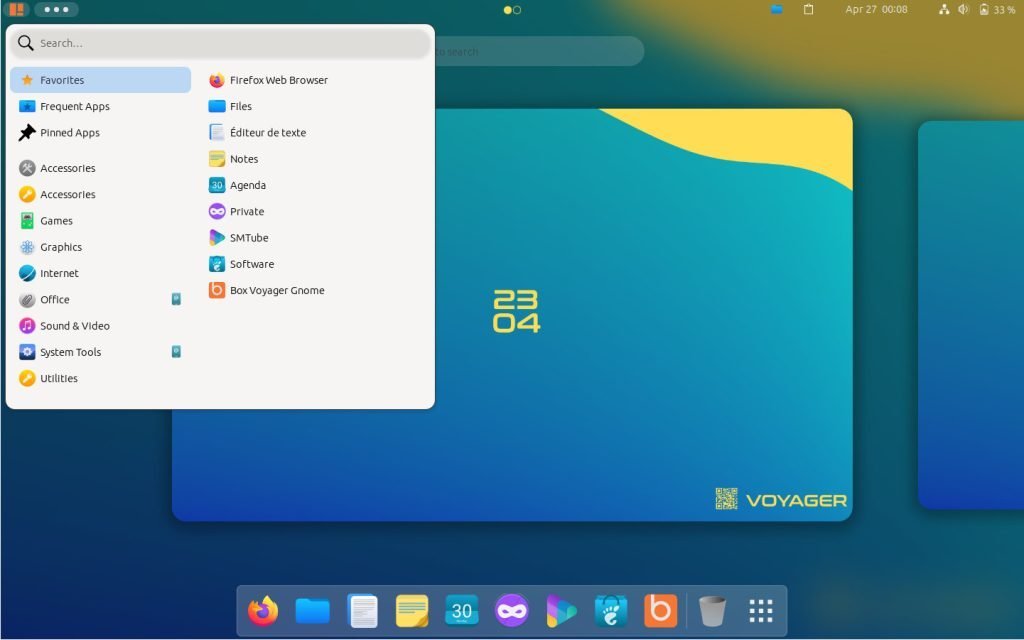
Applications, Snap and Flatpak
Voyager Linux doesn’t include Snap by default at all, despite being Ubuntu-based. Also, Voyager Linux 23.04 moved away from Ubuntu’s decision to remove Flatpak from this release onwards. So, in summary, you get Flatpak integration by default without any traces of Snap in Voyager Linux 23.04. Not only that, the Firefox web browser is packaged from the native deb modules and it’s not the snap version.

The application list is quite big and well-organized. Key apps include Gedit text editor, Files, Firefox web browser, GIMP and LibreOffice suite. Also include Thunderbird email client, Remmina remote connection app, Transmission torrent client and Pidgin messenger.
Voyager includes Pitivi, MPV and Rhythmbox all together for playing videos and music. For productivity and documents, it includes Maps, Calender, Foliate reader app, KeePassXC and scrcpy android screen mirroring tool.
Since the primary ISO file include both Xfce and GNOME desktop, hence you get to experience a few native Xfce apps as well.

Box Voyager
Voyager Linux comes with its own nice little app called “Box Voyager”, which gives you one-point access to all the desktop customizations. It has a list of configuration items and you can launch respective settings directly using this app.
Furthermore, for more customization, you can use several Conky themes which are pre-installed in Voyager Linux. You don’t need to face the hassles of installing and configuring Conky.

Performance
With all the customizations and extensions installed, the performance is pretty impressive. It uses 1.3 GB of RAM at idle, and the CPU is at 1%. However, as you install and open more apps, the performance metrics can go up.
However, due to many pre-loaded apps and Xfce desktops, it uses around 14 GB of disk space for installation. Also, as I mentioned earlier, the entire installation requires 24 GB of free disk space.

Wrapping Up
After reviewing the Voyager Linux 23.04, I believe that it can be an ideal non-Snap Ubuntu variant which can be used on a daily basis. If you don’t like the default appearance of Ubuntu GNOME and are looking for a pre-configured distribution with a stable Ubuntu LTS/short-term base that also has an appealing design, then Voyager Linux could be the perfect choice for you.
Also, the best of all is an option for Xfce desktop with the same Ubuntu base. Give it a try.
You can download Voyager Linux on the official website .
Share this:
Posted by Arindam
This site uses Akismet to reduce spam. Learn how your comment data is processed .
forgot password

- RecentChanges
- HelpContents
- VoyageLinux
- Attachments
Derivatives Census VoyageLinux
Voyage linux.
- Corporate sponsor:
- Government sponsor:
- Funding model: donation and sales of hardware products
- Location: Hong Kong
- Research publications:
- hardware certification:
- Debian IRC:
- devel list:
- Debian list:
- user forums:
- devel forum:
- Debian forum:
- Security contact:
- Debian page:
- Distrowatch page:
- Distribution type: live image | installable (tarball)
- Debian derivative model: uses Debian binary packages, modifies some of them and adds new source/binary packages
- Debian archive quantity: overlay
- Based on: Debian stable
- Interfaces: console
- Init systems: sysvinit systemd
- Build status:
- Build tools:
- Image build: from scratch
- Bug tracker:
- Bugs forwarded to Debian:
- Package tracker:
- Architectures: amd64 i386
- dpkg vendor: Debian
- Patches repo:
- Docs about Voyage Linux for Debian developers:
- Docs about Debian for Voyage Linux developers:
- Voyage Linux glossary:
- Package comparison:
- Popcon information:
- Quality assurance information:
- lintian information:
- piuparts information:
- static analysis information:
- list of developers:
- developer blogs:
- developer microblogs:
- derivatives info:
- mirror tools: rsync
- changelogs pool:
- apt repositories (source, binary, stablerelease/nextrelease):
Derivatives/Census/VoyageLinux ( last modified 2018-10-12 03:13:46 )
- Debian privacy policy , Wiki team , bugs and config .
- Powered by MoinMoin and Python , with hosting provided by Metropolitan Area Network Darmstadt .
- elementary OS
- Bodhi Linux
- Regolith Linux
- Buy Me A Coffee ☕️
- Send Me News/Tips
- App Updates
- Linux Mint New
The Voyager Linux Distro Offers an Interesting Spin on Xfce
The Voyager Linux distribution wants to take users on a journey to an “aesthetic and immersive” Linux environment — but does it succeed?
Well, first things first: I’m not much of a distro hopper these days. I’m old and don’t like the hassle of reinstalling.
But I do like to keep an eye on what’s happening out there, in the wider Linux community, especially around Linux distros based on Ubuntu.
This year I’ve spotlighted Regolith Linux , Enso , Peppermint OS 10 , and Zorin OS 15 (among others), all based and built on a solid Ubuntu foundation.
Earlier this week a reader (thanks Ricardo) suggested I take a look at Voyager Live, specifically the LTS release.
So what’s it like?
Voyager Live 18.04 LTS
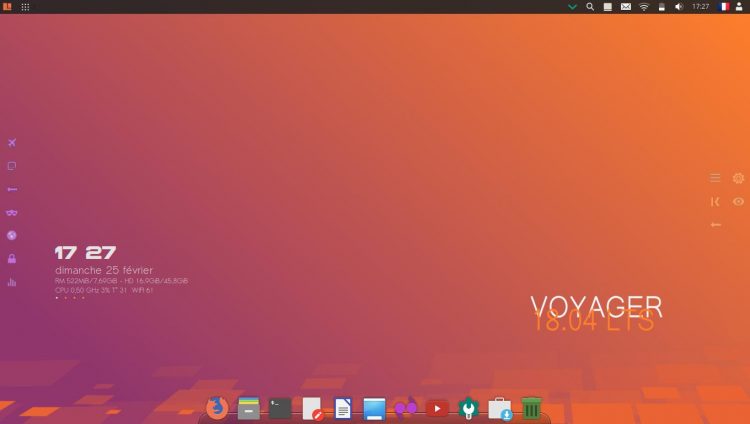
Developed in France, the Voyager Linux distribution is available to sample in several different flavours, including a GNOME Shell based variant.
The version I’m looking at is Voyager 18.04 LTS , a version based on Ubuntu 18.04 LTS and using the Xfce 4.12 (not the most recent Xfce 4.14 release ) desktop environment by default.
From the off you know that you’re using something different with Voyager. The default desktop ‘experience’ weaves together Conky, Plank and Xfce.
Voyager’s heavy use of Conky delivers a raft of on-desktop information and effects by default, including a system resource monitor, network speed display, clock with date, and even a live animated sound equaliser.
Two quick panels are affixed to the left and the right of the screen. These offer shortcuts to a swathe of apps, tools, and settings, including the aforementioned Conky configs, but also Kodi (the media centre), a system info tool (CLI based), and a calendar app.
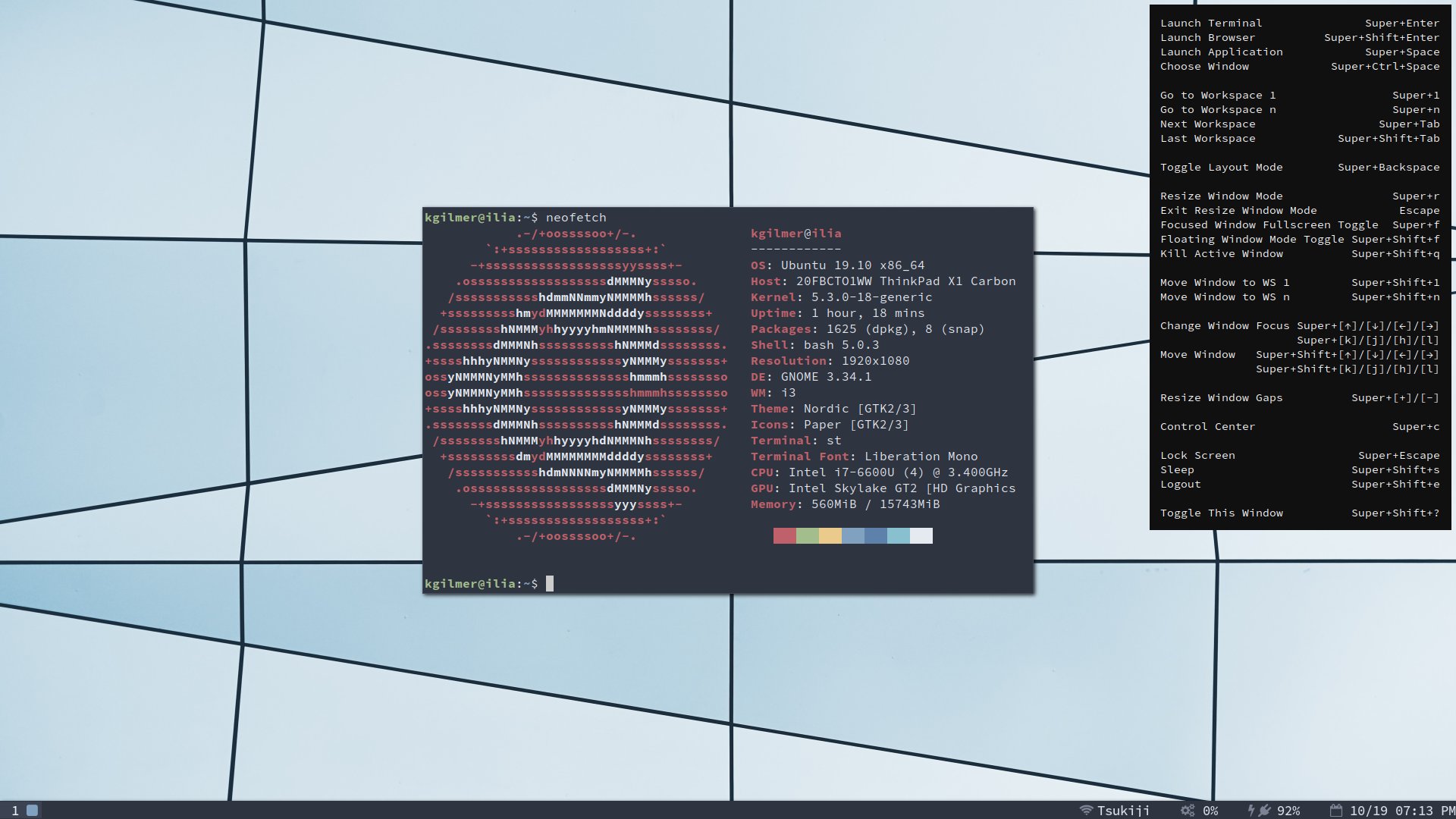
The “cog” icon in the palette on the right opens a prompt from which you can quickly access the preferences section of the various desktop components like Plank and Conky.
So you can also change the appearance and layout of the Voyager desktop to suit your tastes, with many different themes and layouts supplied.
Voyager — which is sometimes called Voyager Live; the particular parlance varies — is stocked with a varied selection of apps by default, including the Kupfer app launcher , Xfdashboard (a GNOME Shell style workspace switcher), the CLI music app moc , and the Smtube YouTube MPV video player.
Regardless of name, Voyager Linux offers up a unique experience set part way off the well-trodden track that the mainstream Linux distros tread.
As a destination, Voyager won’t suit everyone, but for those in the mood to try something a bit different, with the assurances that an Ubuntu based distro offers, it’s well worth exploring.
Voyager Live Website
Share this post
Sign up for our daily newsletter
- Privacy Policy
- Advertise with Us
Voyager X8 – One of the Best Linux Distros You’ve Never Heard Of
Although it might seem hard to believe for the beginner Linux user, there is is life beyond Ubuntu. One of the most notable systems the average user often overlooks is Debian itself, the origin of all Ubuntu and Ubuntu based distros.
Debian offers unparalleled stability in comparison to most other Linux distributions, which is achieved by slower release cycles and deep and thorough testing of the system and all included packages as well.
Debian offers over 30 000 packages from its official repositories and even more from the unofficial ones, but such stability comes at a price: Most packages are what many consider outdated, often lagging one or two minor (rarely major) versions behind what your would normally get from Ubuntu and its derivatives. While you may not get the most up-to-date and bleeding-edge software with a Debian system, you can be sure you have all serious and even minor bugs ironed out, and the chance of anything breaking in production is surely reduced to minimal.
Voyager Live X8
Voyager is a Debian-based distribution, bringing you the newest “experimental” version of XFCE and a great selection of software, based on a stable Debian 8(.1) release.
Debian 8 Jessie comes with XCFE 4.10 and has version 4.12 only in the unstable repositories. Version 4.12 is a major improvement upon 4.10, was in the making for nearly three years, and is the best XCFE release yet according to its developers. It certainly brings plenty of new features to the once lightweight, but lately fully fledged, DE.
Debian users would unfortunately miss this unless they are willing to install it from the unstable repositories which could prove a bit of an advanced stunt to pull even for the more experienced user (that is if they don’t want to risk messing up their entire system).
Fortunately the people behind Voyager X8 made it all easy. Voyager X8 is built on Debian stable with XCFE 4.12 (and nothing else) pulled in from the experimental (unstable) repos. This means unparallelled Debian reliability with a bleeding edge Desktop environment – the best of both worlds.
Voyager X8 also comes with a generous offering of pre-installed software, among others:
- Kodi/XBMC Media Center
- CoverGloobus
- and Transmission
It is noteworthy that Firefox and Thunderbird are not available in Debian systems, only a re-branded version of both Mozilla software (Iceweasel and Icedove, respectively). This is due to the non-free licensing terms Mozilla makes its artwork available under. Debian uses the open-source Mozilla code, but puts it under a re-branded and GPL-licensed browser of a different name with similar functionality.
Voyager X8 at a glance
You have a choice to download Voyager Live X8 in 32 bit and 64 BIOS or UEFI versions. Upon starting, the live CD displays some custom artwork and gives an option to start the live environment in different languages, which is a nice touch.

The live environment starts up remarkably fast, and we’re greeted with a custom-themed XCFE 4.12

Voyager aims to add a touch of style to the default look and feel. It is up to you to decide whether you like the slightly OS X-esque Window controls (not really, but that’s the closest to the colorful buttons) and the quite “loud” background image.

The installer can be started with the single desktop icon of the live environment. It is vanilla Debian: no attempt has been made to re-brand, or simplify it in any way, and as such, it is not for the faint-hearted.

Once you get through the many steps of installation, your system reboots (and boots afterwards) remarkably fast. This is in part due to Debian having switched to systemd .
The login screen has a little terminal cheat sheet on its wallpaper,

but XCFE makes it a breeze to configure a system even in a point and click fashion.

A notable features is the inclusion of Slingscold, a HUD style application launcher

besides the usual XCFE menu, that can seem novel for those not used to the environment with its unusual placement of elements.

As has been already mentioned, Voyager comes with many useful applications preinstalled, so after a little configuration you can have a fully-functioning and extremely-stable Debian based system, which will be actively maintained for many years to come.
Not for beginners
The Debian installer is not necessarily beginner-friendly. You get to configure everything manually, but you need to go through many steps, some of which can be intimidating for new users.
Also, Debian tends to install a largely “unconfigured” system. Ubuntu users might be used to having everything done for them, but Debian systems are much closer to the original Linux way, as in one has to configure one’s system manually or semi-manually.
Voyager X8 is somewhere in between. It is not as easy as Ubuntu but not as rough as vanilla Debian either. Non-free, contrib and security update repositories are pre-configured out of the box, and many useful software is added, but the unsuspecting user might find he is not in the sudoers file (thus cannot use sudo OOB). Unlike Ubuntu, Debian enables the root account by default, thus such small details could easily be sorted out by the more willing adventurer. The website offers a simple tutorial for those willing to get their hands dirty about how to perform some basic tasks and customizations (The page is in French, you can translate with this page widget embedded into the site.).
Voyager X8 offers the stability of Debian 8, with the new functionality of XCFE 4.12, usually only available from the unstable repositories. With a more traditional installer, and a need to be set up a bit, it is not meant for the beginner. But for the intermediate to advanced Linux user, Voyager offers an excellent alternative to mainstream distributions. If you are interested in a more user friendly Voyager experience, check out their Ubuntu-based releases on the Voyager website.
Our latest tutorials delivered straight to your inbox
Attila is a writer, blogger and author with a background in IT management. Using GNU/Linux systems both personally and professionally, his advice stems from 10+ years of hands on experience. In his free time he also runs the popular Meditation for Beginners blog.
- News/Opinions/Reviews ▼ Release Announcements News and Headlines DW Weekly DW Weekly / Review Archive News/Article Search Upcoming Releases Opinion Polls Visitor Ratings & Reviews Project Rankings by Ratings Podcasts, Newsletters & Reviews
- Packages ▼ Packages We Track Package Management Package Releases Compare Packages Across Distros Show package versions for all distros
- Find/Submit Distro ▼ Search For Distro Search For Distro - Advanced Major Distributions Waiting List Submit Distribution Discontinued Distributions Random Distribution
- Tutorials & Learning ▼ Search For An Article Questions and Answers Columns Tips and Tricks Columns Myths And Misunderstandings Columns Glossary Simplified Manual Pages
- Related Resources ▼ Other Operating Systems Compatible Hardware Security Advisories Torrent Downloads Upload Torrents Distro Verification Keys Visual Distro Family Tree Linux User Groups
- DistroWatch.com ▼ About DistroWatch Contact Us Page Hit Ranking Page Hit Trends Advertise Frequently Asked Questions Contributing Donate Our Donations Programme


@2023 - All Right Reserved.
Voyager 20.04 LTS: a heavily themed XFCE-based Linux distro

T he Voyager Live operating system has received a long-term update, so new users won’t have to worry about updating their systems for another three years.
However, it makes sense to introduce our readers to the aesthetic Linux distro known as Voyager Live before we begin talking about its latest version. Based on Xubuntu, this operating system comes with a heavily themed Xfce desktop environment. However, there are two other variants of this OS, where the first one accompanies the GNOME shell desktop, and the other is aimed at gamers as it is bundled with Steam, Wine-staging, and Lutris. The creators brand this distro as an efficient, fluid, modern, fast, and light system. Additionally, it also sports a bunch of pre-installed software, which include the Kupfer app launcher, Smtube Youtube MPV video player, Xfdashboard, and a CLI-based music app in moc.
If Voyager Live has caught your interest, let’s see what the latest version of this operating system has in store for us.
What’s New in Voyager 20.04 LTS
With this update, it seems clear that the user interface of the system has been the center of attention. Once you’ve updated to Voyager 20.04, you’ll be greeted by a new eye-catching wallpaper where a man in the foreground is looking at the beautiful sky and mountains.

Voyager 20.04 LTS Desktop
Apart from that, users would also be inclined towards the three Day, Dark, and Night modes, which allow you to change the lighting conditions of the system so that your eyes remain comfortable at all times.
You won’t find the Conky system monitor with many Linux-based operating systems out there, but you will find it in Voyager. However, that’s not all as this aesthetic OS gives its own edge to the way this software looks. Plus, Whisker (application launcher) also comes with three themes, which include Purple, Dark, and Grey.
Now coming to its other features, installing free or owner-drivers is possible right from settings. Plus, PPAs for third-party app updates can also be activated or deactivated. When it comes to the pre-installed applications, Voyager 20.04 LTS will come with PulseEffects, Firefox, VLC Media Player, and Kodi Media Center (just to name a few). Plus, it is possible to get more applications from the software center.
As for the system requirements for this OS, a 2GHz dual-core processor along with 2GB RAM and 25GB free disk space should be enough. Even with such low specs, if possible, for users to get an even faster experience out of Voyager by choosing any of these Services options in Settings.

Voyager 20.04 LTS Services
With that being said, systems with 32-bit architecture won’t be able to run this OS since it’s based on Ubuntu 20.04, which requires a 64-bit architecture.
Users who want the advantages of Ubuntu and still want to try out something new should definitely take a look at the Voyager Live operating system. And, all thanks to this update, Ubuntu users won’t feel like going back in time since it inherits all the new features from Ubuntu 20.04 LTS. Lastly, you can get to learn more Voyager 20.04 LTS from here, which is very detailed.
- Shadow of the Tomb Raider Definitive Edition released on Linux
- South Korea switching their 3.3 million PCs to Linux
- Tails 4.0 RC out now with Linux 5.3, Tor Browser 9.0
You may also like
Top 5 key features in linux mint 20.3..., top new features in fedora workstation 35, top 10 new features in elementary os 6, microsoft’s “cbl-mariner” linux distro installation and overview, what’s new in linux mint 20.2 “uma”, linux kernel 5.13 released, here’s what’s new, leave a comment cancel reply.
Save my name, email, and website in this browser for the next time I comment.
ENHANCE YOUR LINUX EXPERIENCE.
FOSS Linux is a leading resource for Linux enthusiasts and professionals alike. With a focus on providing the best Linux tutorials, open-source apps, news, and reviews written by team of expert authors. FOSS Linux is the go-to source for all things Linux.
Whether you’re a beginner or an experienced user, FOSS Linux has something for everyone.
MORE FROM US
- Ubuntu (311)
- Downloads (257)
- Learn Linux (255)
- Beginner's Guide (178)
- Terminal Tuts (168)
- Featured (124)
- Server (99)
- Linux Mint (98)
- Fedora (93)
- Privacy Policy
- Terms of Use
A PART OF VIBRANT LEAF MEDIA COMPANY.
“Linux” is the registered trademark by Linus Torvalds in the U.S. and other countries.
- Beginner’s Guide
- Terminal Tuts
- Learn Linux
Voyager Linux 23.10 Beta Version: A Detailed Review
In this article, we will delve into the beta version of Voyager Linux 23.10. We’ll explore the user experience, system performance, and some noteworthy features of this distribution. Keep in mind that this is a beta release, so there may be some issues.
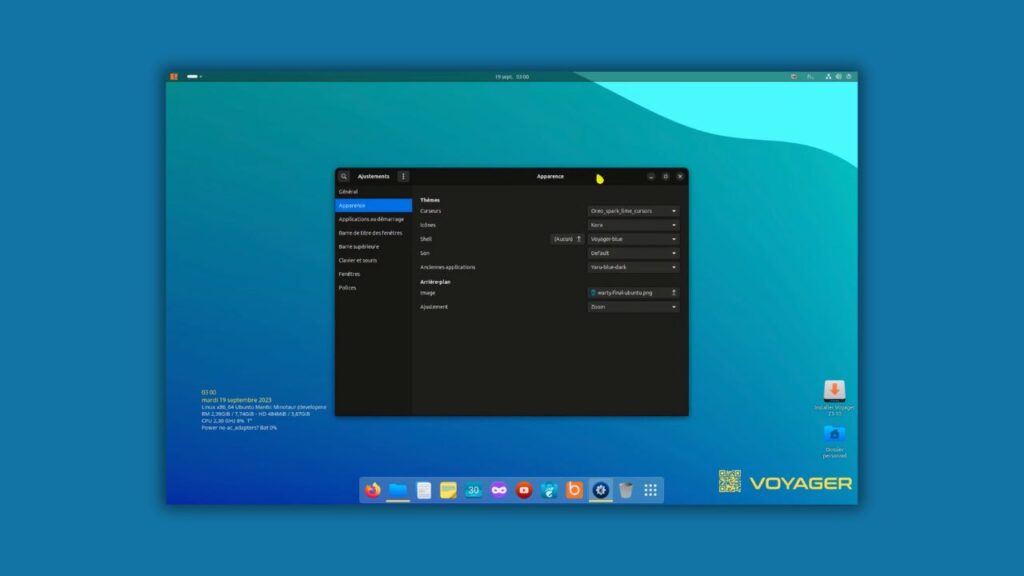
Booting into Live Mode
Upon booting up the beta version of Voyager Linux 23.10, the user is greeted with the boot menu. The first step is to choose the language.
Live Boot vs. Installation
Before proceeding, it’s advisable to initiate a live boot by selecting the “Try Voyager” option. This allows you to evaluate the distribution’s performance and stability. If everything goes smoothly during the live boot without encountering any bugs, you can consider proceeding with the installation.
Installation Process
The installation process is accessible from the desktop. However, it’s recommended to thoroughly test the live boot before making a decision.
Upgrading vs. Fresh Installation
For normal users, upgrading to this beta version is not recommended. It’s better to wait for the stable ISO file to be released before considering an upgrade.
Changing Display Settings
After booting into the live environment, consider adjusting display settings as per your preferences. Check your monitor’s resolution settings to ensure optimal display.
System Information
Here are some details about the system being used for testing:
- Operating System: Voyager 23.10 Beta
- Virtualization: VMware
- CPU: 12th Gen Intel Core i5
- Memory: 4GB RAM
- Hard Disk: 40GB
System Monitor
Monitoring system resource usage is crucial. During the live boot, it’s observed that approximately 2GB of RAM is being utilized . Keep an eye on both RAM and CPU usage to assess system performance.
Performance Observations
During testing, some performance issues were noted. The distribution exhibited lag and sluggishness, particularly when running with 4GB of RAM. Animations and responsiveness were affected.
Command Line Testing
Various command-line tests were conducted to gather system information, including kernel version, running processes, and hardware details.
Installed Applications
Voyager Linux 23.10 Beta comes with a variety of pre-installed applications, providing a range of functionalities.

Resource Consumption
When multiple applications were opened concurrently, RAM usage increased to around 3GB. It’s worth noting that this level of resource consumption may not be suitable for systems with limited RAM.
Application Compatibility
While opening multiple applications, some compatibility issues were observed, causing delays and unresponsiveness in certain cases.
Browser Version
The distribution includes Firefox version 118, which is ahead of the standard Ubuntu release.
Extension Manager
Voyager Linux offers a customizable extension manager to enhance the user experience.
Closing Remarks
In conclusion, the beta version of Voyager Linux 23.10 exhibits some performance issues, particularly in resource-intensive scenarios. It is advisable to wait for the stable ISO file if you intend to use this distribution for regular tasks. If you decide to test it, share your experiences in the comments, as it can help others assess its suitability.
End of Article
Thank you for reading this detailed review of Voyager Linux 23.10 Beta. We hope this information helps you make an informed decision about using this distribution.
- How to Update BIOS on Gigabyte Z690 Motherboard
- 15 Tips to Improve Windows 11 Performance
- 32 Advanced Search Operators Better Google Search Results
- 15 Best Tips & Tricks for Edge Browser
Leave a comment Cancel reply
Save my name, email, and website in this browser for the next time I comment.
- Embedded/IoT
- Open Source
- System Administration
- Certification
- What is Linux?

Do More With Less: 802.1Q VLANs with Voyage Linux
Link: enterprisenetworkingplanet.com
RELATED ARTICLES MORE FROM AUTHOR

Maintainer Confidential: Challenges and Opportunities One Year On
Bridging design and runtime gaps: asyncapi in event-driven architecture, implementing opentelemetry natively in an event broker, innovation as a catalyst in telecommunications, linux 6.8 brings more sound hardware support for intel & amd, including the steam deck.
Fix your IT problems, for good, with tiny fanless computers
- Your account
- Custom cases
- Case studies
- Software images
- Documentation
- Our customers
- Browse shop
- Download Voyage Linux
If you’re looking for all the flexibility and choice that Linux offers, then Voyage Linux can provide you with the platform you need.
This is a standard install of Voyage Linux using the voyage.update script that comes with the software.
It is based on Debian and so includes apt-get which allows you to easily install any other packages you might need.
For full details of the image, please check the readme file (see below).
For the official Voyage Linux release, please go to linux.voyage.hk
Note: If you are upgrading from Voyage 0.4.1 on the ALIX 2 or ALIX 3, you will need to adjust the BIOS settings for this image to boot. The MGMFT workaround option will need to be turned off. Please contact us if you need help doing this.
Pre-built images of Voyage Linux
Devices supported by these voyage linux images, get it installed for you.
We’ll install your software of choice for free when you buy one of our standalone servers or a rack mount server (including a Compact Flash or SD card).
You can also add one to any CF or SD card purchase for only $10.
Just select the operating system you want from the product options, and your order will arrive with the image pre-installed on the CF card, so you can just plug it in and go.
Do it yourself
You can write these images to a Compact Flash or SD card yourself, using dd (BSD/Linux) or Physdiskwrite (Windows).
If you don’t have them already, you’ll need a CF or SD card and a CF/SD card reader (or a CF to IDE adapter ).
Note: All of the above images were created and tested on SanDisk cards, unless otherwise specified.
A note on image sizes
For best results, use the same cf card size.
These images have been built on particular size Compact Flash cards.
Flashing an image onto a CF card of the same size will generally give you the best results, making the most of the available space and ensuring that the image will boot.
If you use a CF card that is smaller than the image, it will most likely refuse to boot.
If you use a CF card that is larger than the image size, you will end up with inaccessible space (unless you know how to repartition the card).
There’s no harm in using a larger CF card if that’s all you can get your hands on. You just might have some wasted space.
Voyage gives you access to space for extra files
Although the Voyage Linux image file is 2GB in size, the operating system files take up less than 150MB.
Voyage Linux allows you to use this leftover space for storing additional files.
Note: If you buy a server or CF card from us with Voyage Linux pre-installed, we can install it onto any size CF card for you, giving you access to even more storage space.
Other software
There are lots of great open-source operating systems that you can use on the APU, ALIX, net5501, net6501 and fitPC’s.
We’ve listed a selection of this amazingly useful software to give you even more options.
We’re not the experts
We supply these files purely for your convenience and can’t make any promises about their suitability for your project.
We can’t provide technical support for these images, because we’re not experts in these operating systems, and don’t want to pretend that we are.
If you’re unsure, please get technical advice from a suitably qualified expert before proceeding.
Note: These images are not endorsed by the creators and maintainers of Voyage Linux.

Our customers say…
"You cannot hold or "feel" the quality of a photo. These units are exceptionally built and look great." Read more Brian Whiting Sydney NSW
"As always, very quick to get a reliable and power efficient little machine into my hands." Read more Shane Pearson Sydney NSW
"The care taken to package everything is something I only get with the likes of Apple!" Read more Rhys Terranora NSW
"Initial setup has been a breeze, and my initial impression of these fine devices is fantastic." Read more Trevor Kenward TK Technologies, Boondall QLD
"Very cool little box, which I'm using for my small office network. The best thing is that it is silent!" Read more Edward Irvine Waramanga ACT
"Pricing, timeframes, support, all of it 10/10." Read more Terry Gilsenan Corporate IT Manager, InterOil Corporation, Cairns QLD
"Products are brilliant, postage is extremely fast. I will not be purchasing elsewhere." Read more Ben Howell Peninsula Computer Solutions, Mornington VIC
"Yawarra far outclass other options and at a more competitive price." Read more Tyson Day Construction Software, Melbourne VIC
"Our ALIX 2-3 firewalls have replaced 3 Cisco routers at a fraction of the cost." Read more Dan Barrett Police Credit Union Ltd, Adelaide SA
"Glad to find someone in Australia who specialises in small network devices." Read more Adrian Vesnaver QLD
"Paul helped me come up with a solution for internal failover using a firewall system from Yawarra." Read more Tim Robertson Bundaberg, QLD
"I really like that it can do 900 bits per second instead of the usual 100 bits per second, plus the 4 ethernet ports." Read more Warwick Lake Warwick Lake Affiliated Endeavours Cootamundra, NSW
"Yawarra firewalls are second to none. Fast, sexy and bulletproof." Read more Matthew Vickers Quispiam Power Computing, Sydney NSW
"The first device I purchased - a net5501 - all those years ago is still going strong." Read more Josh Cavalier Advance Computing, Shepparton VIC
"The ALIX 2-3's reliability and customisation for the price is excellent." Read more Ben Gray Tech 247
"Using Rident with CARP on a net6501 to build a redundant firewall solution worked perfectly." Read more Kevin Bedford Net Ideas Pty Ltd , Narre Warren South VIC
"Fantastic service and definitely went the "extra mile" to help me get up and running. Repeat orders to follow!" Read more Iain Scott MET Services, Murarrie QLD
"It's a pleasure to purchase from a vendor that specialises in Linux." Read more Jason White Burwood East VIC
"You sell products that rock, your communication rocks, you guys rock. Thanks!" Read more Peter Mickelton Perth, WA
"The workmanship on the [APU 1 rackmount] case is amazing." Read more Josh Padman NSW
Best-selling computers
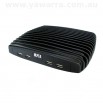
Sign up for updates
Sign up for email updates and we'll donate $5 to Voyage Linux.
Latest news
Get 20% off store-wide for 4 days only, the easiest way to install an operating system onto an apu, what is the difference between the apu1, the apu2 and the apu3, 5 things i love about the apu server case (video), building an apu 1 wireless server (video), christmas and new years hours for 2016, rackmount servers price increase.
- Get support
- Download pfSense
- Download m0n0wall
- Download Rident
- Useful software
- Books and tutorials
- A quick overview
- Placing an order
- Payment options
- Shipping and delivery
- Warranty and returns
- International orders
- Terms and conditions
Looking for something?
Or try here….
- What our customers say
- Catch up with our latest news
- What is sustainable computing?
Tel: 1300 859 799 enquiries@yawarra.com.au
We put a little bit of ♥ into every box
Copyright © 2024 Yawarra Tiny Computers
About our website
tiny shiny cool stuff
New Website
We have moved! Check out our flash new website here . This will take you to our Fanless Compute range- but don't forget to check out the rest of the store! So many exciting new products.
Feel free to contact us at [email protected] if you have any questions.
No orders will be processed through this website.
Support Voyage Linux
Enter your details and click the big blue button below to subscribe to our email list.
Stay on our list for 90 days or three emails, whichever comes first, and we'll donate $5 on your behalf to support the ongoing development of Voyage Linux.

Your privacy is 100% guaranteed.
Navigation Menu
Search code, repositories, users, issues, pull requests..., provide feedback.
We read every piece of feedback, and take your input very seriously.
Saved searches
Use saved searches to filter your results more quickly.
To see all available qualifiers, see our documentation .
- Notifications
When your fav linux journey site voyaged during vacation, it chose to get settled on github pages.
linuxvoyage/linuxvoyage.github.io
Folders and files, repository files navigation.
This repository is one of the ways to go through the English Version of Linux Journey Course - https://linuxvoyage.github.io/
Linux Journey is a site dedicated to making learning Linux fun and easy.
LunaGNUisance/linuxjourney for ordering the content.
web.archive.org for copying the original site's styles
itamarg365/linuxjourney for helping to serve locally.
Usage - Serve the MD lessons with python3 app
From your machine:, from a typical container:.
To serve from container, you might need to specify host address and port as
- running uvicorn will try to host at 127.0.0.1 which did not work while testing out of container
- you might have port 80 occupied for some other project.

Other minor issues:
If you find any lesson/page missing in a lesson, feel free to checkout the live version / 2023 version of Linux Journey here . Note: Quiz Q/A and translations will not work as expected.
Brief History
Though Linux Journey was created to document the journey of the original author and their contributors to learn Linux, everyone's journey is a little different. So, One fine day, the linuxjourney.com website went down and open source community was concerned. Hence, someone volunteered to help us serve it locally and then put it together as static site. After over 2 months, it seems the domain owner/author of the site, resurrected it up again. So, Now We can further improve the knowledge of the greater Linux community through contribution and collaboration, again. Feel free to refer to below issues and may be make a contribution or PR. Good day!
Related GitHub Issues:
The text content of this repo (Linux Journey) has been made free to modify and distribute. For full license terms see: Creative Commons Attribution-ShareAlike 4.0 International License . This license does not include the images, site design and source code which is subject to All Rights Reserved.
- Python 0.1%

Learn the ways of Linux-fu, for free.
Get updates about new courses and lessons!
Grasshopper

Getting Started
What is Linux? Get started with choosing a distribution and installation.

Command Line
Learn the fundamentals of the command line, navigating files, directories and more.

Learn basic text manipulation and navigation.

Advanced Text-Fu
Navigate text like a Linux spider monkey with vim and emacs.

User Management
Learn about user roles and management.

Permissions
Learn about permission levels and modifying permissions.

Learn about the running processes on the system.

Learn all about the dpkg, apt-get, rpm and yum package management tools.

Learn about Linux devices and how they interact with the kernel and user space.

The Filesystem
Learn about the Linux filesystem, the different types of filesystems, partitioning and more.

Boot the System
Learn about the stages of the Linux boot process.

The most important part of the Linux system, learn about how it works and how to configure it.

Learn about the different init systems, SysV, Upstart and systemd.

Process Utilization
Learn resource monitoring with top, load averages, iostat and more!

Learn about system logs and the /var/log directory.
Networking Nomad

Network Sharing
Learn about network sharing with rsync, scp, nfs and more.

Network Basics
Learn about networking basics and the TCP/IP model.

Learn about subnets and how to do subnet arithmetic!

Learn how packets are routed across networks!

Network Config
Learn about network configuration using Linux tools!

Troubleshooting
Learn about common networking tools to help you diagnose and troubleshoot issues!
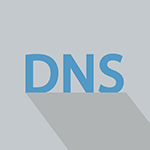
Everything and more that you wanted to know about DNS.
Recommended Resources

One of my most highly recommended books!

Extremely comprehensive book for every SysAdmin.

Great comprehensive guide to shell scripting.

For serious Linux-users, great start into kernel programming.

IMAGES
VIDEO
COMMENTS
Une communauté linux infinie et variée. Un système d'exploitation libre. Voyager respecte votre vie privée. Vous n´êtes plus un produit. Pas de collecte d´infos pour la pub. Pas de bridage système. Pas de virus. Vous aimez Voyager live. Vous pouvez aussi faire un don du montant de votre choix pour aider à sa création et aux ...
Voyage Linux is a fairly new contender in the embedded space. Based on Debian Etch, it weighs in at about 64 megabytes. A nice feature it retains is apt-get for package management, so you'll need to allow extra room for package management. 128 megabytes should be plenty. This is unusual for tiny Linux distributions, which usually jettison any ...
Voyager Linux (aka Voyager Live) is a Ubuntu LTS and Debian-based Linux distribution which features a customized desktop experience with out-of-the-box themes, icons, wallpapers and Conky widgets. It brings GNOME, Xfce desktop experience with its customizations. Moreover, Voyager Linux also offers separate editions for Gaming and Tablet devices.
Voyager Linux 23.10: Features. Voyager Linux is no stranger to the Linux scene, known for its strong foundation on Ubuntu with a dash of Debian charm. Previously, it adhered strictly to Ubuntu's LTS (Long Term Support) cycle, but it expanded its horizons last year to encompass short-term Ubuntu releases.
Status: Active. Popularity: 51 (186 hits per day) Voyager Live is an Xubuntu-based distribution and live DVD showcasing the Xfce desktop environment. Its features include the Avant Window Navigator or AWN (a dock-like navigation bar), Conky (a program which displays useful information on the desktop), and over 300 photographs and animations ...
On 24th August 2021, the Voyager team has announced the release of Voyager 11. It is the first release from the Voyager Linux project with Debian 11 Bullseye Foundation. Voyager 11 completely discards its flagship Xfce desktop and is moving towards a GNOME shell experience.
If you are unaware, Voyager Linux is based on Ubuntu Linux with great customizations for the GNOME desktop. Earlier, it used to follow only the Ubuntu LTS cycle, but from last year, it's also available for short-term Ubuntu releases. After the Ubuntu 23.04 "Lunar Lobster" release, the Voyager team announced the release of Voyager 23.04.
Currently, Voyage Linux has the following editions: Voyage Linux - the basic version . Voyage MPD - Music Player Daemon . All editions are delivered as distribution tarball and Live CD in i386 architecture. AMD64 architecture is available for Voyage Linux only. We also offer SDK to ease customizing Voyage Linux, using Live framework.
Registered. Download Voyager for free. I present to you Voyager 23.10 non LTS and 22.04 LTS Edition Explorer in final version. A 2-in-1 version with, for the first time, the Gnome and Xfce desktops unified in a single Voyager distribution, to be selected during your session.
Voyager Linux (aka Voyager Live) is a Ubuntu LTS and Debian-based Linux distribution which features a customized desktop experience with out-of-the-box theme...
Voyager Live 18.04 LTS. Developed in France, the Voyager Linux distribution is available to sample in several different flavours, including a GNOME Shell based variant. The version I'm looking at is Voyager 18.04 LTS, a version based on Ubuntu 18.04 LTS and using the Xfce 4.12 (not the most recent Xfce 4.14 release) desktop environment by ...
Voyager Live X8. Voyager is a Debian-based distribution, bringing you the newest "experimental" version of XFCE and a great selection of software, based on a stable Debian 8 (.1) release. Debian 8 Jessie comes with XCFE 4.10 and has version 4.12 only in the unstable repositories.
When your fav linux journey site voyages during vacation, it chose to get settled on github pages. - Linux Voyage
Rodolphe Bachelart has announced the availability of Voyager Live 11, a major new release of the project's Debian-based desktop Linux distribution with a customised GNOME desktop. This version is derived from the recently-released Debian 11 "Bullseye" and it comes with a variety of non-free firmware pre-installed.
UNIX and Linux System Administration Handbook, 5th Edition. Extremely comprehensive book for every SysAdmin. Linux Command Line and Shell Scripting Bible. Great comprehensive guide to shell scripting. The Linux Programming Interface: A Linux and UNIX System Programming Handbook. For serious Linux-users, great start into kernel programming.
When it comes to the pre-installed applications, Voyager 20.04 LTS will come with PulseEffects, Firefox, VLC Media Player, and Kodi Media Center (just to name a few). Plus, it is possible to get more applications from the software center. As for the system requirements for this OS, a 2GHz dual-core processor along with 2GB RAM and 25GB free ...
Free Download. Voyage Linux is an open source and free distribution of Linux derived from the award-winning and highly acclaimed Debian GNU/Linux operating system, designed to be deployed on low-end computers, as well as on embedded systems, such as ALIX/WRAP, Atom-based boards or Soekris 45xx, 48xx and 65xx.
Voyager Linux offers a customizable extension manager to enhance the user experience. Closing Remarks. In conclusion, the beta version of Voyager Linux 23.10 exhibits some performance issues, particularly in resource-intensive scenarios. It is advisable to wait for the stable ISO file if you intend to use this distribution for regular tasks.
The only way to install Voyager Linux is to download the ISO release of the operating system from the internet. Luckily, Voyager Linux is hosted on SourceForge, so the download speeds are very fast. To get your hands on the latest Voyager Linux ISO file, follow the step-by-step instructions below. Step 1: Head over to the Voyager Linux website ...
We've covered a lot of ground in the first three parts of this series. Today we stride down that last mile: setting up 802.1Q VLANs, and making configurations permanent. This is the part where you might regret going with an inexpensive smart switch like our example Netgear GS108T. It supports creating 802.1Q VLANs, but at …
This is a standard install of Voyage Linux using the voyage.update script that comes with the software. It is based on Debian and so includes apt-get which allows you to easily install any other packages you might need. For full details of the image, please check the readme file (see below). For the official Voyage Linux release, please go to ...
Though Linux Journey was created to document the journey of the original author and their contributors to learn Linux, everyone's journey is a little different. So, One fine day, the linuxjourney.com website went down and open source community was concerned.
UNIX and Linux System Administration Handbook, 4th Edition. Extremely comprehensive book for every SysAdmin. Linux Command Line and Shell Scripting Bible. Great comprehensive guide to shell scripting. The Linux Programming Interface: A Linux and UNIX System Programming Handbook. For serious Linux-users, great start into kernel programming.